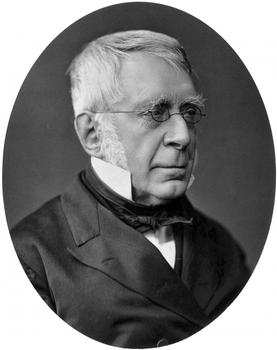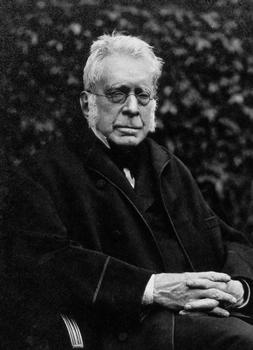English mathematician and astronomer.
Biographical Information
| Name: | George Biddell Airy |
|---|---|
| Born on | 27 July 1801 in Alnwick, Northumberland, North East England, England, United Kingdom, Europe |
| Deceased on | 2 January 1892 in Greenwich, London, England, United Kingdom, Europe |
Short Biography of Sir George Biddell Airy
George Biddell Airy was the eldest child of William Airy – a farmer, later a tax collector – and his wife Ann Biddell. He attended Colchester Grammar School, where he learned mathematics and physics in addition to Ancient Greek and Latin. After leaving school, Airy's wealthy uncle recommended that he study mathematics in Cambridge. With the financial support of his uncle, Airy was able to complete his studies and in 1823 graduated with distinction from Trinity College as bachelor of arts. He was awarded the Smith Prize, the highest mathematics award the university can bestow, and also became senior wrangler. One year later he was elected a fellow of Trinity College, where he had already given lectures in mathematics and astronomy, and by 1826 had gained a master of arts, to which he added the Lucasian professorship for mathematics in the same year. On the advice of William Herschel (1738 –1822), Airy applied for an astronomy professorship in Dublin, but William Rowan Hamilton (1805 – 1865) was given the post instead. However, this did nothing to thwart his amazing scientific career; in 1828 he gained the Plumian professorship for astronomy and became director of the new observatory in Cambridge, and from 1835 to 1881 he was director of the Greenwich observatory. Airy's scientific and organisational activities manifest themselves in more than 500 publications on astronomy and other areas of science. In all his work he showed a special interest in the direct application of mathematics, particularly for engineering science problems; and this is what caused Airy to become involved in a heated debate with Arthur Cayley (1821 – 1895), an advocate of pure mathematics. Airy became an honorary member of the Institution of Civil Engineers in 1842 and was a much-sought-after adviser to the British construction and railway engineering fraternity. He had close connections to Thomas Bouch (1822 – 1880), William Henry Barlow (1812 –1902), Isambard Kingdom Brunel (1806 – 1859), William Fairbairn (1789 – 1874) and Robert Stephenson (1803 – 1859). Airy gave impetus to the building of the Britannia Bridge (1846 – 1850) by investigating the strains inside beams, which was the subject of a lecture he gave to the Royal Society in London in December 1862; this lecture was later printed in the Society's Philosophical Transactions [Airy, 1863]. Airy considered the beam to be an elastic plate and founded the theory of stress functions which was continued by Maxwell and completed by Michell. In 1870 Maxwell called the stress function F(x,y) of the plane stress state the “Airy stress function”, a designation which since then has been an important concept in elastic theory.
Main contributions to Structural Analysis
- On the Strains in the Interior of Beams [1863]
Source: Kurrer, Karl-Eugen The History of the Theory of Structures, Wilhelm Ernst & Sohn Verlag für Architektur und technische Wissenschaften GmbH, Berlin (Deutschland), ISBN 3-433-01838-3, 2008; p. 712
Relevant Publications
- George Biddell Airy, 1801-1892. In: Minutes of the Proceedings of the Institution of Civil Engineers, v. 40, n. 1875-2 ( 1875), pp. 253-255.
- (2008): The History of the Theory of Structures. From Arch Analysis to Computational Mechanics. 1st edition, Wilhelm Ernst & Sohn Verlag für Architektur und technische Wissenschaften GmbH, Berlin (Germany), ISBN 978-3-433-01838-5, pp. 712.
- (2018): The History of the Theory of Structures. Searching for Equilibrium. 2nd edition, Wilhelm Ernst & Sohn Verlag für technische Wissenschaften, Berlin (Germany), ISBN 978-3-433-03229-9, pp. 963.
- About this
data sheet - Person-ID
1010139 - Published on:
17/02/2015 - Last updated on:
17/02/2015





